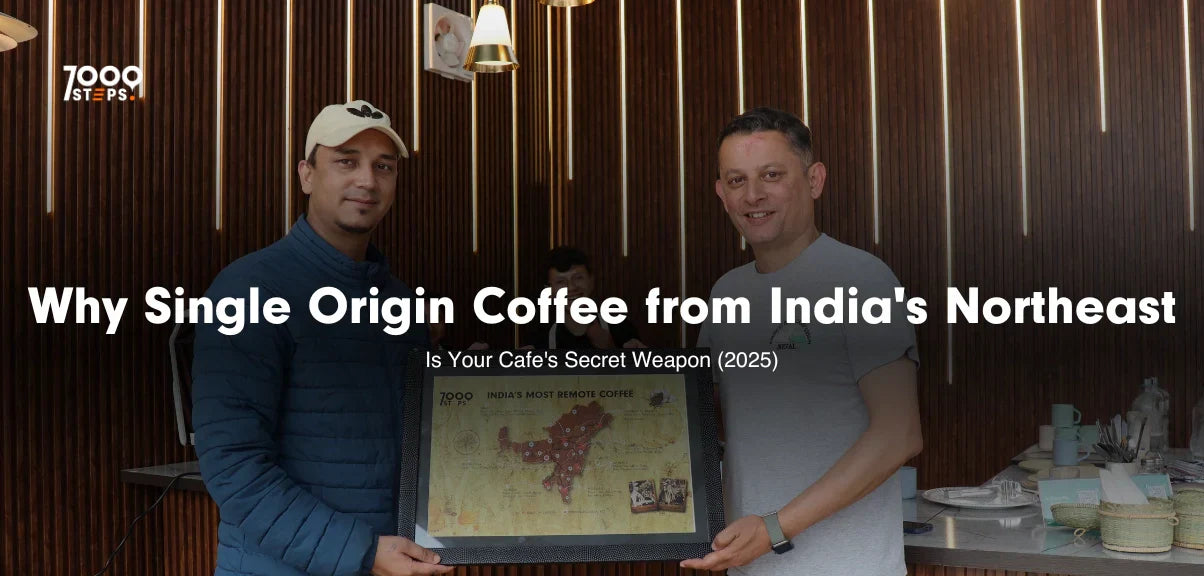Why Single Origin Coffee from India's Northeast Is Your Cafe's Secret Weapon (2025)
Posted on July 21 2025,
Karnataka grows 71% of India's coffee. Kerala adds another 21%. Tamil Nadu contributes 5%. These are the states with the press coverage, the recognition, the established names. But something quiet is happening in the hills of India's Northeast. Shillong's oldest plantation has been growing coffee for over a century. Today, these remote farms aren't chasing attention—they're earning it.
India ranks as the world's 6th largest coffee producer. The numbers matter, but the story behind Northeast India's beans matters more. These are organic plantations. Handpicked harvests. Single origin coffee that doesn't need to shout about what it is. Nagaland coffee scores above 84+ on the Specialty Coffee Association scale not because of marketing, but because of method.
The coffee doesn't stay in the hills. It travels to Cape Town, Singapore, Dubai, Italy, Germany, and Bahrain. Not through distributors pushing volume, but through people who recognize something different. The Land Resources Department of Nagaland leads this revival authenticity rooted in resilience. Our beans grow in one of India's last untouched coffee regions. They're harvested by hands that know the land's rhythm, not its rush.
For cafes looking beyond the obvious choices, Northeast Indian coffee offers more than another origin story. It offers truth. When 81% of younger coffee drinkers pay extra for genuine experiences, this isn't about trends. It's about depth. Character. Connection to a place that doesn't pretend to be anything other than what it is.
Single Origin Coffee Doesn't Need Explanation. It Needs Experience.
Single origin coffee tells you where it comes from. Not in broad strokes or marketing speak, but with the specificity that matters. This isn't about a fundamental shift in coffee culture it's about getting back to what coffee was before blending became convenient.
What Single Origin Actually Means
A single origin coffee comes from one place. Not scattered farms across a region, not a blend designed for consistency, but beans from a specific location. The designation can be as wide as a country or as precise as a single farm plot within an estate. Coffee estates began marking their origins in the 18th and 19th centuries—long before it became a marketing advantage.
The difference lies in traceability. Single origins create a direct line between your cup and the hands that grew those beans. You know the farm. The altitude. The processing method. The harvest date. This transparency doesn't exist to satisfy curiosity—it exists because the details matter.
Coffee drinkers pay up to 200% more for beans with clear origins. Not because single origin sounds premium, but because traceability supports farmers who work without shortcuts. When you know where your coffee comes from, you can choose who deserves your business.
Single Origins Stand Alone
Blends combine beans from multiple regions to create consistent flavors, often built for espresso or milk-based drinks. Single origins do the opposite they showcase what one place can produce when left alone.
The flavor comes from factors that can't be replicated:
-
Coffee variety specific to that region
-
Soil and climate conditions
-
Traditional processing methods
-
Harvesting techniques passed down through generations
Single origins typically receive lighter roasts that preserve their distinct characteristics rather than overwhelming them with roast flavor. Blends might prioritize consistency and predictable results, but single origins prioritize honesty about what the beans actually taste like.
According to specialty coffee experts, blends often lack the transparency that makes single origin coffees special. Both have their place, but only one tells you the whole story.
Why Cafes Choose Truth Over Convenience
Cafes feature single origins because customers recognize authentic flavors tied to specific places. These aren't just different options they're different experiences entirely.
Brewing methods like pour-over, cold brew, and AeroPress give single origins space to express themselves. Traditional preparation might mask these subtle notes, but proper brewing reveals them. For cafe owners, single origins signal more than quality—they signal commitment to the source.
The third wave coffee movement of the early 2000s emphasized traceability and ethical sourcing. This movement didn't create demand for better coffee—it revealed demand that was always there.
Coffee from Northeast India fits naturally into this story. The terroir is untouched. The cultivation methods are traditional. The flavor profiles are distinctive. These beans don't need to become something else to succeed—they already are what cafes and customers are looking for.
The Hills Didn't Ask to Become Famous
Northeast India was tea country for decades. Coffee was an afterthought—an experiment that started in 1953 when the first plantations took root in Assam's Cachar District. The real work began in the 1970s, when farmers in Meghalaya's Garo Hills turned to coffee as an alternative to Jhum cultivation that was wearing out the land.
When Surveys Met Reality
The Coffee Board saw potential. They surveyed over 40,000 hectares across 300 villages in seven northeastern states. Numbers on paper looked promising. Reality was harder. With NABARD's backing, approximately 13,000 hectares came under coffee cultivation, and 7,000 hectares eventually found their way to 5,000 tribal growers.
Today, coffee grows across 6,039 hectares in seven states: Assam, Mizoram, Tripura, Meghalaya, Nagaland, Arunachal Pradesh, and Manipur. The land was always right for it—rich biodiversity, fertile soil, altitude that favors Arabica. The land was never the problem.
Nagaland's Restart
Nagaland's coffee story started in 1981 when the Coffee Board introduced cultivation to the state. It struggled. Transportation was difficult. Markets were distant. Technical knowledge was limited. For over three decades, it limped along.
The turnaround came in 2015. The state government moved coffee development to Nagaland's Land Resources Department. Internet connectivity improved. Market access opened. Most importantly, people who understood the land started making decisions about the land.
The results speak quietly for themselves. Nearly 250 coffee farms now cover 10,700 hectares across 11 districts. About 9,500 farmers tend these farms. Eight roastery units operate alongside homegrown cafes in cities like Dimapur and Kohima, and even in interior districts. Not because of headlines, but because of hands.
Support That Actually Supports
The Coffee Board's Special Area Program focuses on tribal tracts, employment generation, and ecological balance. They provide subsidies for expansion, market support, technical training, and help with processing and marketing. It's methodical work—the kind that doesn't make news but makes progress.
The Land Resources Department builds nurseries. Provides free saplings. Supports farm maintenance. Invests in pulpers, washing stations, curing units. They've established 16 coffee cafes, 12 washing stations, 7 roasteries. They organize training sessions and exposure trips. This isn't development by announcement it's development by doing.
The Coffee Board has identified over 200,000 acres of tribal land for potential coffee expansion beyond southern India, with harvesting expected within the next decade. Nagaland currently uses only 1.08% of its potential coffee-growing area. The state aims for 50,000 hectares by 2047.
The hills didn't ask to become famous. They just kept growing coffee.
The Cup Tells the Story
Northeast Indian coffee doesn't taste like anything else. Not because we're trying to be different because the land makes it different. The hills, the soil, the way morning mist clings to coffee plants growing beside wild herbs. Every sip carries the fingerprint of a place that hasn't been tamed by industrial agriculture.
What You Taste When You Taste Our Coffee
The first thing you notice is brightness. Brighter acidity and delicate flavors that wake up your palate, with citrus notes threading through honey-like sweetness. These aren't flavors added or engineered—they're what happens when coffee grows slowly, at altitude, surrounded by the native plants of Northeast India.
Nagaland coffee brings something else to the cup. Earthiness that speaks of ancient soil. Spice that whispers of the cardamom and cinnamon growing nearby. Fruity undertones that come from forest berries dropping their seeds into the same earth. The hints of forest herbs aren't marketing poetry they're what you get when coffee plants share space with wild flora that's been here for centuries.
This complexity comes from intercropping. Coffee plants grow alongside cardamom, cinnamon, clove, and nutmeg across India, and those spices leave their mark on the beans. The result is a cup that doesn't just taste like coffee—it tastes like a place.
The Land Shapes the Bean
Terroir isn't a fancy word. It's reality the way place becomes flavor. High-altitude growing conditions above 1,000 meters slow everything down. Cool temperatures extend the ripening season, and extended ripening builds flavor. Dense, concentrated beans carry more story in every sip.
Each state contributes something different. Arunachal Pradesh's iron-rich red soils create vibrant acidity and fruit notes. Meghalaya's organic-rich earth produces coffee with sweet lime and grapefruit a direct result of wild citrus trees growing among the coffee plants. The large temperature swings between day and night slow maturation further, allowing sugars to accumulate and flavors to develop complexity. Research confirms what farmers already know: high altitude and moderate rainfall create more aromatic, pleasantly acidic coffee.
How We Keep the Flavor Alive
Processing is where flavor lives or dies. Our farmers know this. Natural processing—whole cherries drying in mountain sun adds the fruitiness of blueberries, strawberries, and tropical fruits. Washed processing creates clean, bright profiles that let the bean's true character shine.
Some farms experiment with honey processing, leaving fruit mucilage on beans during drying. This creates balance natural sweetness with body that showcases terroir without masking it. But the real difference comes from hand-harvesting perfectly ripened cherries and sun-drying on raised beds. Traditional methods that preserve aromatics in ways machines cannot.
The flavor advantage isn't a marketing claim. It's the result of place, process, and people working together without shortcuts.
The Hands That Know
Coffee doesn't grow itself. Behind every cup from Northeast India stand people whose knowledge runs deeper than any manual, whose methods predate any certification. This isn't a story about disruption or innovation it's about continuity. Hands that have worked this land for generations, now growing coffee that travels the world.
Ao, Sumi, Lotha, Konyak—Names That Matter
The indigenous tribes of Nagaland don't just grow coffee—they understand it. Ao, Sumi, Lotha, and Konyak farmers form the backbone of production, but their contribution goes beyond labor. Their traditional intercropping methods involve growing coffee under forest canopies alongside ginger, oranges, and native trees—preserving the ecological integrity of the land while creating beans with distinct flavor profiles.
Five districts tell this story: Mokokchung, Tuensang, Wokha, Mon, and Kohima. Coffee sourced from these areas reflects generations of farming wisdom. When the British East India Company introduced large-scale coffee cultivation to India in the 18th century, these indigenous practices were already creating sustainable growing environments. They weren't called sustainable then. They were just called farming.
Women See What Others Miss
Every coffee cherry gets picked by hand in India. Most of those hands belong to women. This isn't tradition for tradition's sake it's recognition of skill. Women consistently demonstrate superior attention to detail in cherry selection and processing. They know the difference between ready and almost-ready, between perfect and good enough.
34% of workers in India's coffee curing and manufacturing sector are women. In Northeast India, that number tells only part of the story. Women's cooperatives don't just participate—they drive quality improvements. In Zunheboto, one farmer and cooperative leader has mobilized over 80 women across five villages in Nagaland, transforming them from laborers into entrepreneurs and advocates of sustainable coffee.
This isn't empowerment as a program. It's empowerment as practice.
Why Northeast Coffee Works for Cafes That Want to Stand Apart
Cafe owners know the challenge. Every origin story sounds the same after a while. Every "unique" bean promises to change everything. Northeast Indian coffee doesn't make those promises. It just delivers something different and that difference matters.
Built for Brewing Methods That Matter
These beans respond to pour-over and filter brewing like they were grown for it. The Arabica from these hills carries bright acidity without the sharp edges, medium body without the weight. When you brew them slow, they open up. Citrus notes, forest herbs, the kind of complexity that makes customers pause and actually taste what they're drinking. Pour-over brewing grows 10% annually among specialty cafes. These beans arrived right on time.
Sustainable Because That's How the Land Works
The sustainability story here isn't about certifications it's about necessity. Forest canopy growing. No chemical inputs. Traditional methods that work because they've always worked. Direct trade relationships mean farmers get fair compensation, not because it's trendy, but because it's right. When customers ask about your sustainability practices, you can tell them about methods that preserve biodiversity while producing exceptional coffee. No marketing speak required.
The Story That Builds Loyalty
Cafes that feature Northeast Indian coffee don't just serve another origin they introduce customers to something most people haven't experienced. These beans let you create signature drinks that highlight distinct flavor profiles rather than masking them. Research shows 67% of specialty coffee drinkers value uniqueness in their selections. This coffee delivers uniqueness that's earned, not manufactured.
Riding a Wave That's Just Beginning
Indian coffee consumption grows 5-6% annually twice the global average. Domestic appreciation for Indian-grown specialty coffee has surged. Premium cafes in metropolitan areas increasingly feature local origins, and specialty coffee from states like Nagaland now commands premium pricing. Not because of hype, but because of quality. Getting in early means your customers discover something special through your cafe first.
The Real Story Doesn't Need a Perfect Ending
Northeast Indian coffee isn't chasing headlines or market domination. It doesn't need to. The story writes itself in every cup—citrus notes that come from wild trees growing alongside coffee plants, spice undertones earned through intercropping with cardamom and cinnamon, forest herb hints that reflect the untamed land where these beans grow.
The people behind these beans don't farm for certifications or awards. Tribal communities like the Ao, Sumi, and Konyak have been working this land with methods that respect both tradition and necessity. Women select each cherry by hand, not because it's artisanal, but because that's how quality happens here. Young entrepreneurs build roasteries and train baristas because their communities need work, and their coffee deserves proper treatment.
Cafes looking for something real have found it. Not because Northeast Indian coffee promises to change everything, but because it offers what it is—beans grown slow, processed with care, roasted by people who understand the weight of their work. Pour-over brewing suits these beans because their flavors don't need to be masked or blended away.
The numbers tell one story: Indian coffee consumption grows 5-6% annually, twice the global average. Specialty coffee drinkers pay premiums for unique experiences. But the truth tells another—this coffee exists because farmers in remote hills wake before sunrise and tend to plants that don't always cooperate with plans or projections.
We're not here to predict the future of Indian coffee or promise that Northeast origins will reshape the industry. We're here to share what we know: these beans come from one of India's last untouched coffee regions, they taste like the place they're from, and they're grown by people who've earned the right to call this work their own.
That's enough.
Key Takeaways
Northeast India's single origin coffee offers cafes a unique competitive advantage through exceptional quality, authentic sustainability, and compelling storytelling that resonates with today's conscious consumers.
• Distinctive flavor profiles: Northeast Indian coffee delivers bright citrus notes, subtle spices, and forest herb undertones perfect for pour-over brewing methods that showcase complexity.
• Authentic sustainability story: Tribal farmers use traditional organic methods and forest canopy growing, creating genuinely sustainable coffee without marketing gimmicks.
• Market timing advantage: With Indian coffee consumption growing 5-6% annually and rising demand for local specialty coffee, these beans position cafes ahead of trends.
• Premium quality credentials: Nagaland coffee scores 84+ on Specialty Coffee Association scale, demonstrating international-level quality from this emerging region.
• Brand differentiation opportunity: Featuring these unique origins helps cafes build customer loyalty through storytelling and exclusive offerings that mass producers cannot replicate.
The convergence of exceptional terroir, traditional farming wisdom, and growing market appreciation makes Northeast Indian single origin coffee an ideal secret weapon for forward-thinking cafes seeking authentic differentiation in 2025.
FAQs
Q1. What makes single-origin coffee from Northeast India unique? Single-origin coffee from Northeast India offers distinctive flavor profiles with bright citrus notes, subtle spices, and forest herb undertones. These unique characteristics are a result of the region's terroir, traditional farming methods, and careful processing techniques.
Q2. How does Northeast Indian coffee compare to other Indian coffee regions? While traditional regions like Karnataka dominate production, Northeast Indian coffee is gaining recognition for its exceptional quality. For instance, Nagaland coffee has scored above 84 on the Specialty Coffee Association scale, demonstrating international-level quality from this emerging region.
Q3. Is Northeast Indian coffee sustainably grown? Yes, most Northeast Indian coffee is grown using organic practices and traditional methods. Tribal farmers often cultivate coffee under forest canopies without chemical inputs, creating a genuinely sustainable product that appeals to environmentally conscious consumers.
Q4. Why should cafes consider offering Northeast Indian coffee? Cafes can use Northeast Indian coffee as a unique selling point to differentiate themselves in a competitive market. It allows them to tap into the growing demand for Indian specialty coffee, build brand identity, and create signature drinks that highlight distinct flavor profiles.
Q5. How is Northeast Indian coffee typically best brewed? Northeast Indian coffee beans are particularly well-suited for pour-over and filter brewing methods. These techniques showcase the coffee's complexity, nuanced flavor profiles, and bright acidity, creating a clean cup without overwhelming bitterness.



0 comments